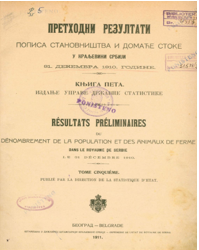History of the Census
-
Conducting the censuses in the Republic of Serbia has the long-lasting tradition. The first general census was conducted in June 1834 - by order of Prince Miloš. This census did not include the Turks (who were not enumerated later as well) and the Roma people, who were exempted from the census because they were not subject to general taxation. In addition to houses and tax payers, the census also included conscripts.
From the first general census of mankind/ population until the First World War, censuses were conducted almost every five years on average: 1841, 1843, 1846, 1850, 1854, 1859, 1863, 1866, 1874, 1879, 1884, 1890, 1895, 1900 , 1905,1910. The census conducted in October 1866 is considered to be the first modern census. Under the leadership of Vladimir Jakšić, the founder of the statistics in Serbia, serious preparations were made for the implementation of the mentioned census, forms and rules of the enumeration were made and a large number of new features was included. This census covered the entire population.
The next census, conducted in December 1874, was even more ambitious. The preparation of this census was more extensive and the collected data were presented at lower territorial units (counties, municipalities).
The Statistical Department was preparing a new census action for the end of December 1880, in accordance with the recommendations of the International Statistical Congress held in 1872 in Petrograd (Russia). However, the war with Turkey, in 1877 and 1878, as well as the post-war political circumstances prevented the implementation of this action. In the meantime, at the Berlin Congress (1878), Serbia received full international recognition of independence, on the territory expanded by the districts of Nis, Pirot, Vranje and Toplica. In order to determine the number of people and taxpayers in the liberated areas, a partial census was conducted in these so-called new areas, only seven months after the Berlin Congress, in February 1879.
The census from 1884 differs from all previous censuses, because it was conducted on the basis of the law - "Law on the Census of People and Property". Since then, all censuses on the territory of Serbia have been conducted on the basis of special legal regulations.
The desire to adapt statistical observation to modern scientific requirements and the recommendations of international statistical congresses expressed itself in 1890, with the adoption of the "Law on Census of Population and Livestock", according to which “censuses should be conducted every five years, at the same time, on December 31st". The last census in the Kingdom of Serbia was conducted in 1910. The most significant difference of this census in relation to the previous ones is reflected in the fact that in addition to the so-called Family list, an individual census slip – Questionnaire was introduced for the first time.
The last census in the Kingdom of Serbia was conducted in 1910. The most significant difference of this census in relation to the previous ones is reflected in the fact that in addition to the so-called Family list, an individual census slip – Questionnaire was introduced for the first time.In the period between the two world wars, only two censuses were conducted, in 1921 and 1931. The next census was planned for March 1941, but due to political events and the beginning of the Second World War, it was not conducted.
Due to the need to collect data on the damage caused by the war destruction as soon as possible, in 1948 the so-called "shortened" census was performed, and already in 1953 the first complete post-war population census.
Starting with the 1961 census, in accordance with UN recommendations, ten-year periodicity was re-established, so that the censuses were conducted in 1961, 1971, 1981 and 1991.
The first census in the 21st century, and the first after the disintegration of the SFRY, in the then Federal Republic of Yugoslavia, which consisted of Serbia and Montenegro, was planned for April 2001. However, due to the lack of financial resources, first the state authorities of Montenegro, and later of Serbia, made the decision to postpone the census. The census was conducted in Serbia in April 2002, but only encompassed the territories of central Serbia and AP Vojvodina, because there were no conditions for its implementation on the territory of AP Kosovo and Metohija, while Montenegro conducted the census in 2003.
2011 census is the first census that the Republic of Serbia conducted as an independent state in 100 years. This census was not conducted in April (as was previously the practice), but in October, with significant financial support from the European Commission. 2011 census was not conducted on the territory of the Autonomous Province of Kosovo and Metohija, while in the municipalities of Bujanovac and Preševo, recorded was the decreased coverage of census units due to the boycott of a large number of members of the Albanian national minority.


